|
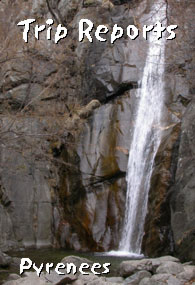 |
||||||||||||||||||||||||||||||
TRIP REPORTS: |
|||||||||||||||||||||||||||||||
Trip reports from participants of Catalan Bird Tours' birding holidays and bird watching tours to the Pyrenees will be posted here.My blog and photos are also below. |
|||||||||||||||||||||||||||||||
For more Trip Reports: |
|||||||||||||||||||||||||||||||
Date |
Author |
Clients |
|||||||||||||||||||||||||||||
| a | |||||||||||||||||||||||||||||||
28 September 2006 |
Stephen Christopher |
Brian and Lucy Coleman, England |
|||||||||||||||||||||||||||||
“Thanks again for the excellent two days we birded together and the information you provided for the rest of my holiday. It was very useful to travel with a knowledgeable birder who understands the natural history of the birds and their distribution when visiting new areas and looking for specific species.Both Lucy and I found both days nicely paced with plenty of variety and many opportunities to not just simply tick off the birds but to observe them as well.”Brian and Lucy Coleman, England |
|||||||||||||||||||||||||||||||
|
Black Redstart
|
Golden Eagle
|
||||||||||||||||||||||||||||||
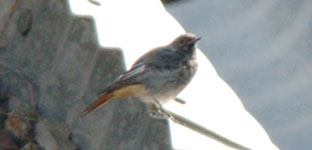 |
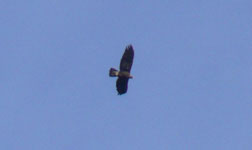 |
||||||||||||||||||||||||||||||
|
6 july 2006
|
|||||||||||||||||||||||||||||||
6 July 2006 |
Stephen Christopher |
Ian and Jonathan Moig, Scotland |
|||||||||||||||||||||||||||||
"Once again thank you for two terrific days birding.The scenery on the walk up to the Pyrenees left quite an impression on Jonathan."Ian Moig, Scotland |
|||||||||||||||||||||||||||||||
|
Red-backed Shrike
|
Common Crossbill
|
||||||||||||||||||||||||||||||
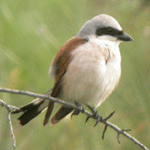 |
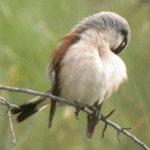 |
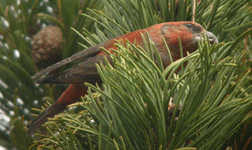 |
|||||||||||||||||||||||||||||
|
29 May 2006
|
|||||||||||||||||||||||||||||||
29 May 2006 |
Stephen Christopher |
Carl Cornish + 4, U.K. |
|||||||||||||||||||||||||||||
‘Rubbish’ was how the day started for Carl Cornish, a Conservation Officer from The Nottinghamshire Wildlife Trust, and his four work mates as, when I arrived to pick them up from their hotel near Bagà, they were already cursing a refuse truck that had reversed into the side of their hire car.Thankfully, their birding day started off on a much better note as, even on the first roadside stop for coffee and biscuits, we immediately picked-up Rock Bunting, Serin, Firecrest, Bonelli’s Warbler and, perched on a bush not ten metres away, an absolutely stunning Red-backed Shrike.Two hours later however, after waiting most of that time at my favourite Lammergeier spot without joy, I was beginning to wonder if the day was cursed after all. Not that we hadn’t seen anything, with Short-toed Eagle, Common Buzzard, Sparrowhawk and Raven all passing through and Crag Martin and Alpine Swifts skirting the mountain edge, but of course the enigmatic ‘bone-breaker’ was what everyone had come to see. A beautiful singing Sub-alpine Warbler, perched up for all to see, only served to delay the inevitable and so, with lunch fast approaching, a change of tact was called for and we headed back down to the car, grabbed the picnic and made the short ascent up to a viewpoint on the opposite side of the valley.En route we’d collected great views of Grey Wagtail, Crested Tit and Common Crossbill but, as we laid out the food over-looking the whole valley, me afraid even to take a toilet break in case I missed something, I had more than just my fingers crossed that our luck would change soon.As we scoffed and quaffed we began to notice an unusual amount of Griffon Vultures circling and then landing on the steep valley side opposite and a careful scan through the telescope revealed a raptor-watcher’s gift – a Chamois carcass! After watching the throng swarm in and pile up on top of the unfortunate ungulate, and each other, giving the impression that the one in the middle had scored the winning goal in the world cup final, one of the group noticed a Golden Eagle perched on top of a nearby rock. It was soon joined by another and, save for the occasional foray to check out the developing state of affairs, they waited patiently as the vulture pack waned from its peak of near-on one hundred birds.Spotted Flycatcher, Cirl Bunting and Green Woodpecker all came and went but, finally, I was able to shout out the magic word – Lammergeier! Two, in actual fact, and they calmly glided down like cool-headed late arrivals to the best party in town and settled somewhere out of sight.Much happier, we made our way, via a sighting of the usually elusive Cuckoo and the calls of the still elusive Black Woodpecker, to the pass known as the Coll de Pal where we added, despite the late hour, Rock Thrush, the usual flock of Red-billed and Alpine Choughs and, surprise, surprise, another Lammergeier. Definitely not rubbish! |
|||||||||||||||||||||||||||||||
|
Griffon Vultures
|
The Greixer Valley
|
||||||||||||||||||||||||||||||
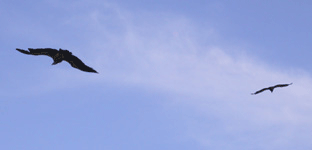 |
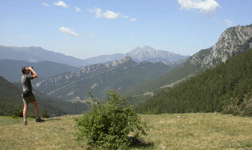 |
||||||||||||||||||||||||||||||
|
a
|
|||||||||||||||||||||||||||||||
16 March 2006 (Day 1) |
Stephen Christopher |
sunny and warm, much ground snow |
|||||||||||||||||||||||||||||
|
Normally Wallcreepers don’t leave their wintering quarters and head back for the shear cliffs of the Catalan Pyrenees to breed until April is well established but, as I arrived at the base of the Camp del Teixó after an hour’s slog through deep melting snow, I thought they’d probably be here before I could muster up the energy to slog all the way back down again. I threw off my backpack, dropped my telescope stand into the soft crunch of the snow and stripped down to my t-shirt. This is a good place for breakfast I decided, not really caring exactly where that place was, and took the opportunity to stock up on oxygen while I was at it. Of course, just as I’d poured out the first flask-lid full of coffee and shared out the chocolate biscuits amongst my self, the soft scream of a Lammergeier sent them all crashing to the ground as I groped for my binoculars. I needn’t have bothered, possibly on the hunt for breakfast itself, this beautiful orange adult floated around like an air commander for about the next hour, even taking the time to settle on a mid-distant peak and wait whilst I set up the scope and took the digi-snap (I won’t call it a photo) now uploaded on to the Pyrenees page (here). Having spotted a sub-adult Golden Eagle flying high above my head and watched it gradually flap itself into a speck, I was suddenly dragged out of that ‘why didn’t it fly this way?’ feeling by a harsh woodpecker-like squeal at tree-height behind me and I swivelled to see another, this time majestically superb full adult, flap itself into the closest view I’ve ever had. That is, until it circled behind the trees and repeated more or less the same flight path two or three times encroaching a little further into my personal space each time. Suddenly I pondered, rather absurdly in the cold light of another day, that it might want me, and I walked quickly towards my 'scope stand just in case. I also picked up my packet of chocolate biscuits and hid them in the lining of my jacket. Well it’s not as if they’ve done a lot of research into this kind of thing. Escorted by countless Rock Bunting as well as Cirl Bunting, Griffon Vulture, Grey Wagtail, Red-legged Partridge, Dipper and a wheeling flock of over a hundred Red-billed Chough, I made my way back down to the car only to find, a few kilometres further on, that the road to the Coll de Pal was snow-closed today. I was sure the Vall de Núria however would make a more than adequate substitute so I headed off blindly, as is my want when I don’t have the responsibility of others to consider, only to be blinded upon my exit from the rack train by a sun-powered blast from acres and acres of pure white snow. Speechlessly beautiful. To be honest, I’d been warned by the ticket lady that there’s no way I could walk the 7km track back down to the bottom, but who could resist making company with Coal and Crested Tits, flocks of singing Citril Finch and an ice-walking Water Pipit? I headed back down to the station in Queralbs, where a Nuthatch whistled me good day and good night. And he was absolutely right. |
|||||||||||||||||||||||||||||||
|
Yellowhammer
|
Citril Finch
|
Water Pipit
|
|||||||||||||||||||||||||||||
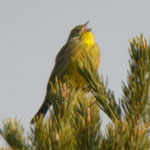 |
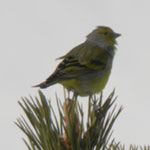 |
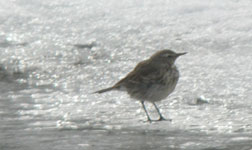 |
|||||||||||||||||||||||||||||
17 March 2006 (Day 2) |
Stephen Christopher |
Very warm, ground snow |
Prat de Cadi |
||||||||||||||||||||||||||||
|
My ‘up with the sunrise’ jaunt to the Prat de Cadí, a mountain meadow in the Pyrenees where, incidentally, Tengmalm’s Owls are known to breed, was sabotaged by the shear weight of bird song filtering through the car window on the way up to Estana, the village from where the trail begins. Wren, Dunnock, Song Thrush, Black Redstart and Coal and Crested Tits were among those serenading me and, like sirens, distracting me from my early morning mission. On one stop, to view a full field of Rock Bunting and Chaffinch, they were conducted from the upper most branches of a poplar tree by the harsh but very welcome pips of a quite beautiful Lesser Spotted Woodpecker. At the Collada de Pallers, after being mesmerised yet again by song, this time mainly from the Yellowhammer and Ring Ouzel around the car park, I finally managed to ditch the car and begin my ascent some three hours later than planned. Only 500 metres into the steep, sometimes snow-covered, forest track I was grateful for the sudden appearance of a small plateau. Apart from birds, a plateau is also good for breakfast - I decided. O.k. so it was past 10.30 a.m. and I’d already had breakfast but chocolate biscuits don’t really count so I unhitched my backpack anyway. As I placed it onto a rock to avoid the melting snow I sensed a shadow pass over me and I instinctively looked up, expecting to see yet another Raven, but was confronted with the spotted underside of a Short-toed Eagle that was so close I could almost verify why it is so-named. Followed a split second later by a second, both flapped silently away at eye level until, just a few moments later, they dropped behind the tree line, leaving me to work my way through over half-a-packet of biscuits before my heart stopped racing. This was turning out to be quite a trip for close encounters with raptors. At the three-hectare meadow itself, which I reached an hour or so later having been chaperoned on the way by Crossbills and Crag Martins, I discovered moving about to be somewhat difficult but was still able to track the drumming of a Black Woodpecker through the adjacent trees. The resulting view was barely more than a wing-beat as it flapped away but still thrilling and well worth the climb nonetheless. A pair of Golden Eagles, an adult and a first-winter (complete with white tail glinting in the sunlight) that had been circling above me a little earlier, therefore, proved to be a bonus. A twenty-minute search for my keys, involving tipping the entire contents of my rucksack onto the bonnet of my car (don’t worry, I always take spares) wasn’t quite enough to prevent a fleeting visit to the Rasos de Peguera, a ski-station conveniently placed on the way home. The bright sunlight seemed to inspire the whole Pyrenees into life today as amongst the constant sound and movement around me, including many more Crossbills and Ring Ouzels, I was able to add an argumentative pair of Short-toed Treecreeper, Mistle Thrush and a Goldcrest. All singing, of course. |
|||||||||||||||||||||||||||||||
|
Rock Bunting
|
Prat de Cadí
|
||||||||||||||||||||||||||||||
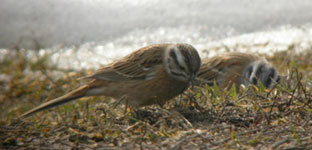 |
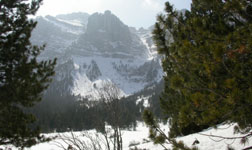 |
||||||||||||||||||||||||||||||
|
|||||||||||||||||||||||||||||||
